|
|
 |
|
|
 |
(The Peterborough Lift Lock section was updated July 13. If you read it before, you might
want to read it again for the added information -- such as the somewhat different reactions of Gayl and Dick to the lift lock
experience.)
July 9, 2005 Peterboro to Lakefield
10.2 miles/2413 Loop total
7 locks/105 Loop total
We got to our first lock before it opened, but we were too late -- there was already a line waiting
behind a big tour boat that filled the lock. We watched as the crew took advantage of the high lock walls to clean
the tops of all their windows and work their way down as the boat rose in the lock chamber. Then they carried plates
heaping with food to the lock crew before leaving for the next lock.
The next lock is one of the famous highlights of the Trent-Severn Waterway -- the Peterborogh Lift Lock.
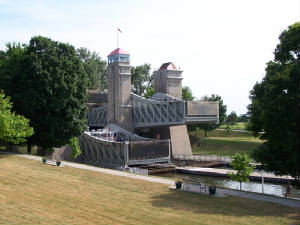
The Peterborough Lift Lock opened on July 9, 1904. We rose in it on July 9, 2005, its 101st anniversary. It
was the 100th lock we passed through on our Loop voyage.
At 65 feet, the lock is the highest of the eight hydraulic lift locks in the world, and the only one made
of concrete. It took eight years to build, from 1896 to 1904. In other words, it took longer to build
this one lock than to build the entire Rideau Canal system.
In this lock, there are two chambers -- and upper chamber and a lower chamber. We pulled our boat
into the lower chamber, and boats at the top of the lock wanting to go downstream entered the upper chamber. The
doors to the lower and upper chambers were closed, then one foot more water was let into the upper chamber. The
added weight of one foot more water caused the upper chamber to move down, pushing the lower chamber up -- like
a big see-saw.
Our trip up was fast -- it only took about 90 seconds, and felt like an elevator. The arc of the tie-up
wall gave the illusion that the tub we sat in was tilting backward as we rose. I had to keep looking at the waterline
on the tub wall for reassurance that we were on a level plane. Looking down to the ground far below from the deck
of a boat is an eerie experience. Dick enjoyed it considerably more than I did.
About 4,000 boats go through the locks each year, they say. Tour boats take people from the Peterborough
Marina to ride the locks. They go up, then turn around and go back down. I wonder if they only count the
tour boats once in their boat count?
After seven locks, we figured we had worked enough for the day, and we tied up at the lock wall in the town
of Lakefield at 1:35. Our boat was in the shade of a tree right next to a picnic table, where we decided to have a picnic
before walking into town.
When Dick turned on the camera to review our pictures from the morning -- great shots of our ascent in the
lift lock plus our best loon close-up shot yet -- the photo images were all just faint shadows on a white background.
After many experiments, we determined that our five-month-old Kodak digital camera was indeed broken. We headed
into the charming little town of Lakefield in search of a back-up digital camera, but all we could find were disposable ones.
We knew there was a Walmart ten miles back in Peterborough, and we found a cab that would take us there,
wait, and bring us back for $30. Since we bought our camera at Walmart in the U.S., we took it with us, just in case we could
convince them to exchange it.
Wonder of wonders -- they had the camera in stock (although not on the shelf), they were willing to do an
exchange for our defective camera, and their current price for the camera was $120 less than we paid for it, so they gave
us a $120 refund. Net, after cabfare and a tip, we have a brand-new camera and $80 in our pocket. All we lost
was a day's worth of priceless pictures.
Lakefield had an all-day jazz festival going on while we were there. By the time we finished messing
around with the camera caper, it was late in the afternoon. We headed over around dinnertime, stopping along the way
to get ice cream cones, just in case they didn't have food available at the festival (they did). We enjoyed two different
acts, neither of them jazz. A man our age crooned Cole Porter/Frank Sinatra standards, accompanying himself brilliantly
on an electronic piano. Then the Channel Cats played outstanding party music that had half the crowd dancing,
and the rest clapping and toe-tapping. We thoroughly enjoyed ourselves, even though we left before the music ended, exhausted
from our busy day.
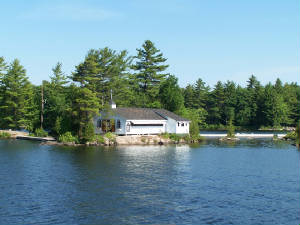
|
| St. Peter's on the Rock Church |
Sunday, July 10 Lakefield to Lovesick
16.6 miles, 3 locks
Our journey today took us through a series of lakes,each with a different personality. Katchewanooka
was slim and shallow. Clear Lake was four miles long, nearly a mile wide, and deep enough to need no channel markers. Its
shores were dense with cottages and boathouses.
Stony Lake was true to its name, with 1128 charted islands peppering its waters. It also sports the
charted locations of Devil's Elbow, Hell's Gate, and Hurricane Point. We heard that Steve Martin and Carmen
Electra are on Stoney Lake shooting "Cheaper by the Dozen 2," but we didn't see them.
Our favorite sight on Stoney Lake was people going to church at St. Peter's on the Rock, a little white
clapboard Anglican church on an island all its own. The church has a small dock where church-goers can tie up.
A sign on the dock says "Blessed are they that create no wake."
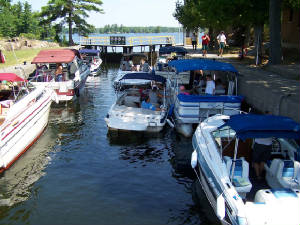
|
| Locking through the popular Lovesick Lock |
We picked our way through the tightly packed islands of Lovesick Lake to get to the popular Lovesick Lock,
which lies between two islands, and is not accessible by land.
From 1899 until 1965 the Lovesick lockmaster and his family lived on the island next to the lock, without
a phone, electricity or indoor plumbing. Now the locktenders come by boat from the next lock.
We were delighted to find there was space available on the lock wall at Lovesick. We tied up, packed
a picnic lunch, and walked across the dam to Wolf Island, a big pink granite island that is protected in an undeveloped state
as a provincial park. We hiked a bit, found a nice picnic spot on a big lichen-covered shady rock at the water's edge,
and enjoyed our lunch (although we spent part of the time eating standing up to avoid aggressive ants).
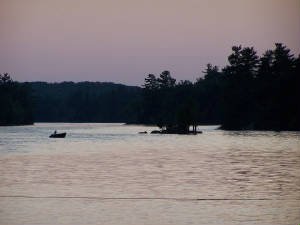
Later in the afternoon we took down our kayaks and went exploring. We followed a couple loons for
a while, skirted some lily pad beds, and explored the shoreline of Wolf Island. We found a pretty little cove,
where we beached the kayaks, swam and sunned on a rock.
We had dinner up on the flybridge watching the sun sink low in the sky and listening to the loons calling
out on the lake.
July 11, 2005 Lovesick to Fenelon Falls
37.5 miles, 2 locks
As we cruised today, we left pink granite island studded lakes behind and headed into limestone-lined lakes
with flat ledges at their shores and no islands or boulders poking up to impede the unwary.
We stopped for lunch at busy Bobcaygeon, a shopper's paradise. As we walked the streets in search
of a place to fax some papers to Cincinnati, we decided you could buy just about anything there. It was a pleasure just
to wander and window shop -- flower baskets lush with bright blooms hung from overy light pole, and every business had flower
displays, as well.
We thought about staying overnight, but news of tropical storm remnants heading north dumping huge amounts
of rain spurred us to get a few more miles in today while the weather was still balmy.
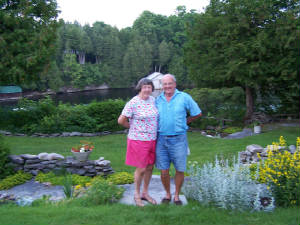
|
| The Hewtons in their cliff-top garden with a view |
We made our way to Fenelon Falls, home of cruising friends Barbara and Norman Hewton, who we met while staying
in Fort Myers this past winter. They had just arrived home from a "shake down cruise" of their new land yacht RV when
we called them from the waterway. They greeted us from their waterside cement dock and patio, helped us dock, tie up
and connect to power (air conditioning!), and invited us to join them for a swim in the river. It was the perfect refreshment
after a long day of cruising in the sun and temperatures in the 90s.
We went out to dinner at a place popular with the locals, topped it off with ice cream from a
great ice cream parlor next door, and then had a little car tour about town with the Hewtons giving us the local lowdown.
We had a wonderful time with the Hewtons. But, best of all, I went to sleep knowing that when
we pulled into the Kirkfield Lift Lock the next day, I would not have to stand on the bow of Starsong holding
a line to secure the boat, while looking out over the 45 foot drop. Norm had offered to be our Trent-Severn Pilot
for the day, and we gladly took him up on his offer.
After you read about Arborvitae below, click here to continue to page 3.
|
 |
|
|
 |
|
|
 |
|
|
|
Arborvitae, tree of life:
We have seen Arborvitae, or Northern White Cedar trees in abundance as we have traveled this segment of
our Loop. They cling tenaciously to rocks, growing in the least bits of soil imaginable. The indigenous peoples
favored white cedar wood for canoe frames, because it was light in weight and easily split. They
also used its bark to start fires.
Looking it up in our tree field guide, I learned that the Northern White Cedar was probably the first North
American tree introduced in Europe. It was discovered by French explorers and grown in Paris in 1536.
Tea brewed from its foliage and bark saved Jacques Cartier's crew from scurvy. Cedar
oil was distilled from its twigs and used for medicine. It was named Arborvitae, Latin for "tree of life,"
in 1558.
|
|
|
 |

